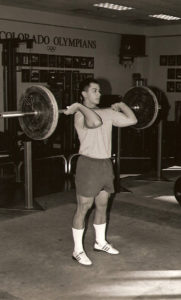Power Clean (5 Phases for full lift)
In mechanical terms, the power clean and the snatch are very similar. The main difference is that the weight, i.e., the bar, is not being moved as far in the power clean as in the snatch. Thus, a larger weight load is permitted. From the UAP, let us compare the power clean to the snatch. The width of the feet in the snatch is a bit closer. The width of the feet in the power clean is at least shoulder width, but may be a little wider depending upon the height of the hips. The grip should be one and one-half hand widths inside the snatch grip (each side). Also, in the power clean, the hips are a little lower compared to the snatch, which requires a higher hip adjustment to compensate for the wider grip. Except for these few adjustments, the two lifts are the same.
Also, while the power clean is the full name, this lift is commonly simply called “the clean.” Other phases include clean pull, clean high pull, clean and press, and clean and jerk.
Phase 1:
This is the first pull. The first pull begins at the middle of the shin and ends at the top of the knee cap. Once again, posture must be correct, arms straight, heels flat, chest up, knees pushed out and eyes straight ahead. The grip for the power clean should be one to two hand grips outside the shoulder to allow for a proper rack (see photos below).
Phase 2:
The second pull: begins at the top of the knee cap and ends at mid-thigh (just as with the snatch). This is the most explosive part of the lift. The arms are still straight and the bar is as close as possible to the body. The feet should begin to leave the floor while shrugging at the same time (again, as with the snatch).
Phase 3:
This phase is called the high pull. It begins at mid-thigh and ends about chest level.
At this point, you should again be fully extended, on the toes, elbows are bent and pointing upward (not back or down). Make sure that the arms remain straight until this phase is reached. If you bend the arms before this phase, you will lose leverage and speed.
Phase 4:
This phase is the rack position. This position is very different than the rack position of the snatch because the bar is going to rest across the clavicle or collar bone with the elbows pointing out and not down. As you make the transition from phase three to phase four the feet should make the audible popping sound again. Be certain to maintain the momentum of the lift or the sound will not be made, i.e., the speed of the lift will be too slow and proper form, along with its benefits, will be lost. Additionally, you will likely not be able to complete the lift. The rack position also has two positions. You can either rack with a little bend of the knees or rack by going down into a full squat position. Both positions should be practiced to become fast at the movement. The primary benefit of the full-squat position is that a much heavier load can be used because the bar does not have to be pulled as high.
Phase 5:
This is again, the recovery position. Just as with the snatch, the recovery is completed by standing straight and tall with the weight resting across the collar bones, feet back to starting position, two long seconds of hold, and the lift is complete. Follow the same steps for the dumbbell version.
Phase 1: Grasp bar and first pull.
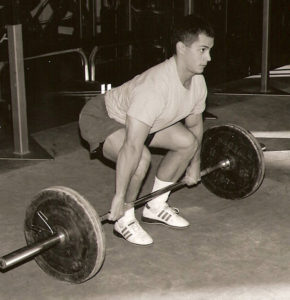
Phase 2: First pull (this phase is the clean pull).
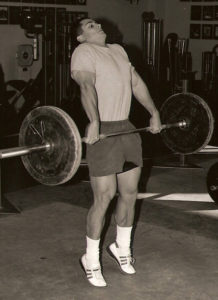
Phase 3: Keep motion of 2nd phase (first pull) going into 3rd pull – this is actually the clean high-pull position.
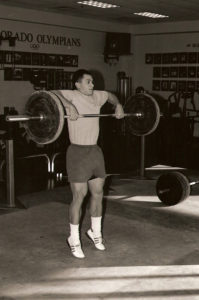
Phase 4a: Keep motion of pull going as your flip/rotate the bar onto your shoulders and begin squatting. At this point you have gotten under the bar to begin final completion of the lift.
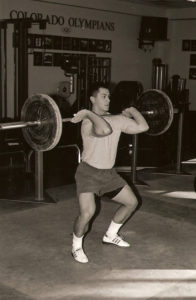
Phase 4b: From the rack position above you move into a full rack, front-squat position. Stabilize your position before attempting to stand.
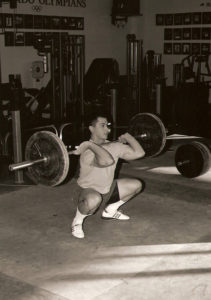
Phase 5: The recovery position. Stand after the squat, stabilize again; drop your bumper weights to the floor – do not hang onto them, just drop them on the platform. Approach bar and begin next repetition.
